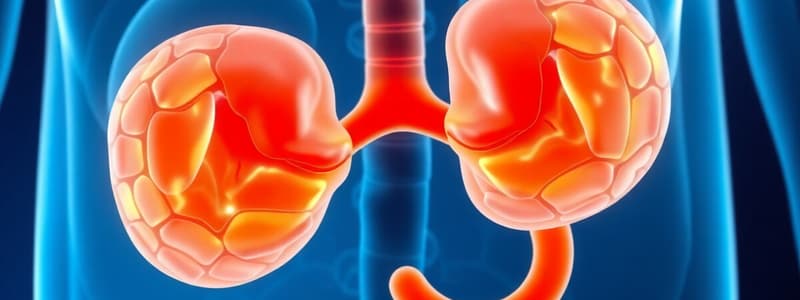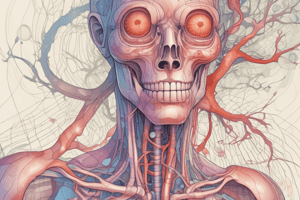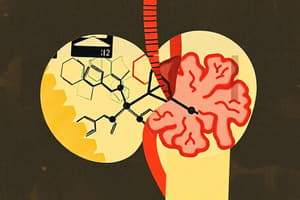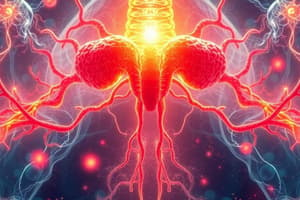Podcast
Questions and Answers
Which of the following is NOT a function of melatonin?
Which of the following is NOT a function of melatonin?
Which cell type in the pancreas produces glucagon, a hormone that increases blood glucose levels?
Which cell type in the pancreas produces glucagon, a hormone that increases blood glucose levels?
What is the primary function of the exocrine pancreas?
What is the primary function of the exocrine pancreas?
Which of the following statements is TRUE about the relationship between insulin and glucagon?
Which of the following statements is TRUE about the relationship between insulin and glucagon?
Signup and view all the answers
What is the role of the pineal gland in regulating circadian rhythms?
What is the role of the pineal gland in regulating circadian rhythms?
Signup and view all the answers
Which of the following statements accurately describes the location of the pancreas?
Which of the following statements accurately describes the location of the pancreas?
Signup and view all the answers
What is the primary effect of insulin on target cells?
What is the primary effect of insulin on target cells?
Signup and view all the answers
Which of the following hormones is primarily secreted by the zona reticularis, and stimulates the development of pubic hair before puberty?
Which of the following hormones is primarily secreted by the zona reticularis, and stimulates the development of pubic hair before puberty?
Signup and view all the answers
Which of the following is NOT a characteristic of diabetes mellitus?
Which of the following is NOT a characteristic of diabetes mellitus?
Signup and view all the answers
How does glucagon contribute to regulating blood glucose levels?
How does glucagon contribute to regulating blood glucose levels?
Signup and view all the answers
Which of the following is NOT a direct effect of epinephrine and norepinephrine release from the adrenal medulla?
Which of the following is NOT a direct effect of epinephrine and norepinephrine release from the adrenal medulla?
Signup and view all the answers
What is the primary difference between the exocrine and endocrine functions of the pancreas?
What is the primary difference between the exocrine and endocrine functions of the pancreas?
Signup and view all the answers
Which of the following statements accurately describes the relationship between the adrenal cortex and the adrenal medulla?
Which of the following statements accurately describes the relationship between the adrenal cortex and the adrenal medulla?
Signup and view all the answers
Which of the following is a primary function of mineralocorticoids, primarily produced in the zona glomerulosa?
Which of the following is a primary function of mineralocorticoids, primarily produced in the zona glomerulosa?
Signup and view all the answers
The secretion of glucocorticoids from the zona fasciculata is primarily regulated by:
The secretion of glucocorticoids from the zona fasciculata is primarily regulated by:
Signup and view all the answers
What is the physiological consequence of a decrease in blood sodium levels?
What is the physiological consequence of a decrease in blood sodium levels?
Signup and view all the answers
How does the release of glucocorticoids from the adrenal cortex impact the immune system?
How does the release of glucocorticoids from the adrenal cortex impact the immune system?
Signup and view all the answers
Which of the following hormones is primarily responsible for the breakdown of glycogen in the liver during the fight-or-flight response?
Which of the following hormones is primarily responsible for the breakdown of glycogen in the liver during the fight-or-flight response?
Signup and view all the answers
Which of the following statements accurately describes the relative proportions of epinephrine and norepinephrine secreted by the adrenal medulla?
Which of the following statements accurately describes the relative proportions of epinephrine and norepinephrine secreted by the adrenal medulla?
Signup and view all the answers
Which of the following is NOT a direct effect of glucocorticoids on the body?
Which of the following is NOT a direct effect of glucocorticoids on the body?
Signup and view all the answers
A patient is experiencing prolonged stress. Which of the following is the dominant hormone during the resistance phase?
A patient is experiencing prolonged stress. Which of the following is the dominant hormone during the resistance phase?
Signup and view all the answers
What is the primary role of thyroid hormones in growth and development?
What is the primary role of thyroid hormones in growth and development?
Signup and view all the answers
Which hormonal effect describes how insulin works to facilitate growth?
Which hormonal effect describes how insulin works to facilitate growth?
Signup and view all the answers
Which of the following is NOT a characteristic of the alarm phase of the stress response?
Which of the following is NOT a characteristic of the alarm phase of the stress response?
Signup and view all the answers
What is the main function of parathyroid hormone (PTH) and calcitriol in relation to growth?
What is the main function of parathyroid hormone (PTH) and calcitriol in relation to growth?
Signup and view all the answers
Which hormone is directly responsible for mobilizing lipid reserves during the resistance phase of the stress response?
Which hormone is directly responsible for mobilizing lipid reserves during the resistance phase of the stress response?
Signup and view all the answers
Which of the following best describes the relationship between growth hormone and insulin in terms of their effects on growth?
Which of the following best describes the relationship between growth hormone and insulin in terms of their effects on growth?
Signup and view all the answers
Why is it crucial for thyroid hormones to be present during fetal development?
Why is it crucial for thyroid hormones to be present during fetal development?
Signup and view all the answers
In the absence of thyroid hormones before puberty, what is the likely consequence on skeletal development?
In the absence of thyroid hormones before puberty, what is the likely consequence on skeletal development?
Signup and view all the answers
Which hormone is primarily responsible for maintaining normal blood glucose concentrations in adults?
Which hormone is primarily responsible for maintaining normal blood glucose concentrations in adults?
Signup and view all the answers
What is the name of the hormone that is produced by the kidneys and helps regulate red blood cell production?
What is the name of the hormone that is produced by the kidneys and helps regulate red blood cell production?
Signup and view all the answers
Which of the following is NOT a function of the endocrine system?
Which of the following is NOT a function of the endocrine system?
Signup and view all the answers
What is the primary difference between type 1 and type 2 diabetes mellitus?
What is the primary difference between type 1 and type 2 diabetes mellitus?
Signup and view all the answers
Which of the following hormones is released by the heart in response to increased blood volume?
Which of the following hormones is released by the heart in response to increased blood volume?
Signup and view all the answers
What is the role of the thymus in the immune system?
What is the role of the thymus in the immune system?
Signup and view all the answers
What is the name of the enzyme that converts angiotensinogen to angiotensin I?
What is the name of the enzyme that converts angiotensinogen to angiotensin I?
Signup and view all the answers
Which of the following is a consequence of poorly managed diabetes mellitus?
Which of the following is a consequence of poorly managed diabetes mellitus?
Signup and view all the answers
Which of the following hormones is primarily responsible for stimulating the development and maturation of sperm?
Which of the following hormones is primarily responsible for stimulating the development and maturation of sperm?
Signup and view all the answers
What is the name of the structure formed after ovulation that releases estrogens and progesterone?
What is the name of the structure formed after ovulation that releases estrogens and progesterone?
Signup and view all the answers
Which of the following organs does NOT have a secondary endocrine function?
Which of the following organs does NOT have a secondary endocrine function?
Signup and view all the answers
Study Notes
Adrenal Glands
- Lie along the superior border of each kidney
- Consists of two main parts: cortex and medulla
-
Superficial Adrenal Cortex
- Stores lipids, notably cholesterol and fatty acids
- Manufactures steroid hormones (corticosteroids)
-
Inner Adrenal Medulla
- Controlled by the sympathetic division of the autonomic nervous system (ANS)
- Secretes epinephrine and norepinephrine (catecholamines)
-
Adrenal Cortex Zones
-
Zona Glomerulosa (SALT):
- Outermost region
- Produces mineralocorticoids, e.g., aldosterone
- Stimulates sodium retention and potassium excretion
- Increased sensitivity to salts in taste buds
- Released in response to blood sodium levels, blood volume, or blood pressure decreasing or potassium increasing.
-
Zona Fasciculata (SUGAR):
- Middle region
- Produces glucocorticoids, e.g., cortisol, corticosterone, cortisone
- Regulated by negative feedback loops, inhibiting CRH (hypothalamus), ACTH (anterior pituitary)
- Effects include accelerating glucose synthesis, glycogen formation (especially in the liver) and anti-inflammatory actions.
-
Zona Reticularis (SEX):
- Innermost region
- Has a branching network of endocrine cells
- Produces small amounts of androgens (sex hormones), such as androgens, under stimulation of ACTH
- Some converted to estrogens
-
Zona Glomerulosa (SALT):
Adrenal Medulla
- Contains two types of secretory cells:
- 75-80% produce epinephrine
- 20-25% produce norepinephrine
- Activation results in:
- Mobilization of glycogen reserves & acceleration of glucose breakdown in skeletal muscles.
- Breakdown of fats into fatty acids in adipose tissue
- Glycogen breakdown in the liver
- Stimulation of cardiac muscle strength and contraction
- Primarily responds to stress
Pineal Gland
- Located in the posterior portion of the roof of the third ventricle
- Contains pinealocytes which synthesize melatonin
- Functions of Melatonin
- Influence circadian rhythms
- Inhibit reproductive functions
- Protect against free radical damage
Pancreas
- Both an exocrine and endocrine gland
- Located in the loop between the inferior border of the stomach and the proximal portion of the small intestine.
-
Exocrine Pancreas:
- Makes up roughly 99% of the pancreas
- Consists of clusters of gland cells (pancreatic acini) and their attached ducts which produce enzymes and alkaline fluid for digestive processes.
-
Endocrine Pancreas:
- Consists of cells clustered into pancreatic islets (islets of Langerhans)
- Alpha (α) cells produce glucagon
- Beta (β) cells produce insulin
- Delta (δ) cells produce a peptide hormone identical to GH–IH
- Pancreatic polypeptide cells (PP cells) produce pancreatic polypeptide (PP).
- Consists of cells clustered into pancreatic islets (islets of Langerhans)
- Insulin: Stimulates transport of glucose into cells; regulates glycogen breakdown in liver and glucose release
- Glucagon: Mobilizes energy reserves; stimulates glycogen breakdown in skeletal muscle and liver cells, stimulates triglycerides breakdown.
Other Endocrine Organs
- Many organs have secondary endocrine functions
- Intestines: Release hormones coordinating digestive activity
- Kidneys: Release calcitriol, erythropoietin, and renin (involved in blood pressure regulation)
- Heart: Produce natriuretic peptides (ANP and BNP) acting to oppose angiotensin II
- Thymus: Produces thymosin to promote lymphocyte development and maturation, affecting immune system
- Testes: interstitial endocrine cells produce androgens, mainly testosterone
- Ovaries: Produce estrogens including estradiol; produces progesterone (after ovulation). Nurse cells (Sertoli cells) support sperm differentiation and produce inhibin for feedback regulation.
- Adipose tissue: secretes leptin to provide feedback control over appetite, and to aid in maintaining normal levels of GnRH and gonadotropin synthesis.
General Adaptation Syndrome (GAS)
- The body's response to chronic stress
- Divided into three phases: Alarm, Resistance, Exhaustion
- Alarm Phase: Characterized by immediate response to stress, directed by sympathetic nervous system, mobilizing energy reserves (primarily glucose), and preparing for "fight or flight" responses.
- Resistance Phase: Occurs if the stress continues, using lipids and amino acids for energy. Conserving glucose for nervous tissue. Glucocorticoids are the dominant hormones in this phase.
- Exhaustion Phase: Occurs with chronic stress as homeostasis breaks down. If not relieved, exhaustion can be fatal.
Hormone Interactions
- Antagonistic Effects: effect depends on balance between hormones
- Synergistic Effects: additive effect of multiple hormones
- Permissive Effect: one hormone is required for another to have an effect
- Integrative Effects: hormones produce different effects, but complementary results
Studying That Suits You
Use AI to generate personalized quizzes and flashcards to suit your learning preferences.
Related Documents
Description
Explore the anatomy and functions of the adrenal glands, including their structure, hormone production, and the specific roles of the adrenal cortex and medulla. This quiz will help you understand the significance of adrenal hormones in regulating bodily functions.




